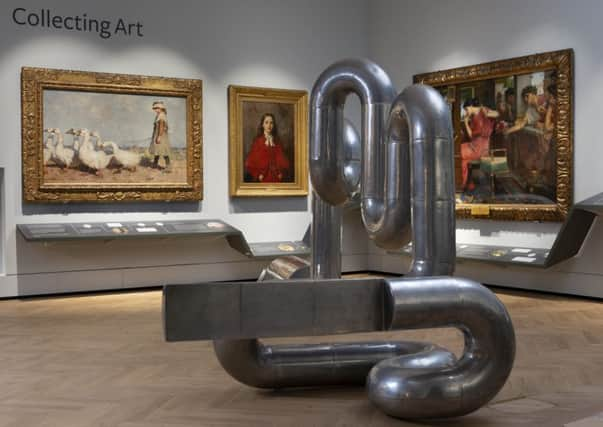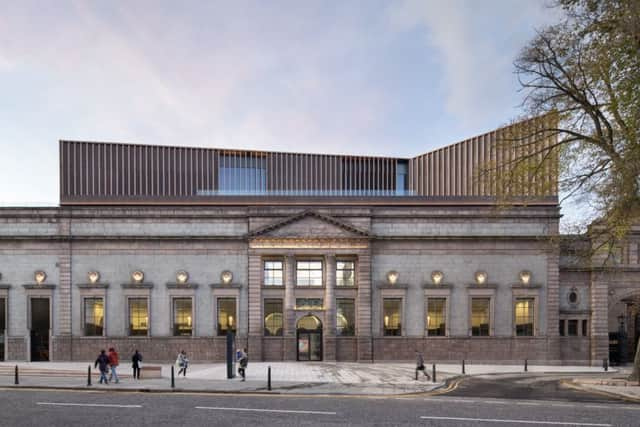Five stars for Aberdeen Art Gallery’s £34.6 million refurbishment


Last weekend, Aberdeen Art Gallery opened its doors after a £34.6million redevelopment which has taken nearly four years. An ambitious refurbishment of the Victorian building by Hoskins Architects has added a new floor, significantly extending the exhibition space available. Time to level with you: Aberdeen is my home town. Aberdeen Art Gallery is the first gallery I went to, the place where I discovered what a thing it is to be able to wander into a museum and look at works of art. It surprised my teenage self that one could do this without asking permission, without even buying a ticket. Free museums are a rare privilege and we must fight tooth and nail to keep them free.
Aberdeen Art Gallery Refurbishment *****
Aberdeen was where I discovered the magic of paintings, the way brushstrokes could evoke moonlight, or the contours of an old man’s face in a way that was somehow more real than the thing itself. But that wasn’t all. There were modern works, bold geometric abtracts and sculptures like Paolozzi’s Gexhi, which to the uninitiated (and I was very uninitiated) looks like something left behind by a giant plumber. These things intrigued me. I didn’t have the tools to appreciate them, but clearly someone thought them worthy of putting in an art gallery and I hoped one day to understand why.


Advertisement
Hide AdAdvertisement
Hide AdI visited the gallery just before it reopened with a mix of excitement and trepidation. I’m well aware that museums today need 21st-century facilities: cafe, shop, accessible toilets, lifts (which, incredibly, Aberdeen never had), education suites. At the same time, I hoped that the place of my memories would be in some way preserved.
Early impressions were encouraging. The Sculpture Hall, with its granite pillars and chequered floor, is intact, and the balcony above with its Elgin Marbles frieze. For the first time there are open sightlines between the gallery, the Memorial Hall (behind the city’s war memorial) and the Cowdray Hall, a small-scale music venue where memories of piano competitions still make me shudder.
The new BP Galleries, where the roof used to be, are bright, modern spaces currently housing two bodies of work by photographer Martin Parr. The first, commissioned by the gallery, captures “Aberdonians at Leisure.” The second, “Think of Scotland,” takes in two decades of Parr’s images of the country: fried breakfasts, highland dancers, tourists in raincapes, a drunk outide a pub, red gowned students in St Andrews, the Calmac ferry. If they tend towards Caledonian cliché at times, they are also both affectionate and true.
But it is in the rehang of the main galleries that we see the wonder which has been wrought by the refurbishment. The fact is that Aberdeen has one of the finest regional art collections in Scotland, perhaps in the UK, and the additional space means we can see three times as much of it as we could when the gallery closed in 2015.
Back in the 1880s, granite merchant Alexander Macdonald endowed a bequest for the purchase of art no more than 25 years old. This was close to revolutionary at the time, and means that Aberdeen has been collecting contemporary art for 130 years.
So, on the foundations of its fine 19th century collection, it has built a major 20th century one: Paul Nash, Stanley Spence, Barbara Hepworth, Bridget Riley, Lucien Freud. Thanks to Macdonald’s stipulation, the gallery was able to buy these artists when major works were still available and prices had not rocketed to present-day levels.
The Victorian painters who first wowed me are still here: William Dyce, Joseph Farquharson, Edwin Landseer, Guthrie’s goose-girl, George Hitchcock’s Maternité, Lavery’s The Tennis Party (currently on display with The Ferryman by William Stott of Oldham, on loan from the Tate). One room pairs European 19th century works with Scottish ones to show the common themes: Fantin-Latour and Leslie Hunter, Daubigny and George Reid, Monet and McTaggart. This collection has such riches they come at you almost casually.
Advertisement
Hide AdAdvertisement
Hide AdThe rooms are arranged according to theme, following particular strands through art history. A room of portraits starts with Ramsay, Raeburn and Reynolds, moving through Wilkie and Rosetti to Cowie, Eardley, a bust of MacDiarmid by Benno Schotz and Freud’s Pope I, Study after Pope Innocent by Velazquez. A room called “Shoreline” has the painters one might expect – Eardley, McTaggart – but also Will Maclean, Dalziel + Scullion and a wall of prints by Ian Hamilton Finlay.
A room of abstracts has Bridget Riley, Jon Schueler, Patrick Heron and Callum Innes. One themed on the human form, and containing only work made in the last 30 years, has Alison Watt, Jim Lambie, Kenny Hunter, Gavin Turk’s memorable Habitat, as well as works by Gilbert & George and the Chapman Brothers. In the Sculpture Court, along with Hepworth and Epstein, are Christine Borland, Lucy Skaer and Tracey Emin.
I hope you’re getting the picture. While many regional galleries no longer have the budget to collect contemporary art, Aberdeen – thanks to Macdonald’s legacy – continues to grow its collection. And there’s not enough space here to go into the decorative arts, jewellery, crafts and textiles, examples of which are also on show.
There’s a great deal of creativity in how the works have been arranged, and there are plenty of surprises: a room themed on Victoria and Albert also includes Rachel Mclean’s film, The Lion and the Unicorn, made in 2014 at the time of the independence referendum. And it is a joy to find a room which builds on the work of the 2016 National Galleries’ Modern Scottish Women show, with work by Dorothy Johnstone (who lived for many years in Aberdeen) and Cecile Walton among others.
A great deal of time has been devoted to the buzzword of accessibility with touchscreen displays and interactive exhibits aplenty. Part of me wonders if they are trying too hard. A collection of this calibre will find its audience.
But another part of me wants this gallery to be accessible. Heck, part of me wants to drag people in off the street to see what has been achieved here. If this collection was in London, people would be queueing to get in. It’s time that Aberdeen Art Gallery got the recognition it deserves and I hope – with a wise and clever redevelopment – it will do just that.